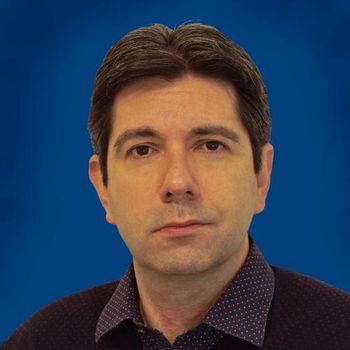
The Role of LIBS in Forensic Anthropology and Bioarchaeology: An Interview with Matthieu Baudelet, Kristen Livingston, and Katie Zejdlik
Matthieu Baudelet, an associate professor of Chemistry at the National Center for Forensic Science at the University of Central Florida, is currently exploring how laser-based spectroscopic techniques can be used in forensic anthropology. Spectroscopy recently sat down with Matthieu Baudelet, Kristen Livingston, and Katie Zejdlik to discuss their research as part of “The Future of Forensic Analysis” content series.
Spectroscopy can help archaeologists identify and characterize materials that help them piece together the history of humanity (1). Spectroscopic techniques, such as laser-induced breakdown spectroscopy (LIBS) and X-ray fluorescence (XRF), are nondestructive and can help build elemental profiles of artifacts and human remains, the same techniques are also applied in other related disciplines, including forensic anthropology. Forensic anthropology studies human remains just like in archaeology. Forensic anthropologists specialize in analyzing remains usually via the tissues left, such as bones, teeth, hairs, and can use them to identify gender, ethnicity, age, illness, pregnancies, and even possible careers. They also bring archaeological practices to outdoor crime scene processing, such as determining whether bones are human or nonhuman (2–4).
Matthieu Baudelet, an associate professor of Chemistry at the National Center for Forensic Science at the University of Central Florida, is currently exploring how laser-based spectroscopic techniques can be used in forensic anthropology. Baudelet received his BS from the University of Lille and an MS degree from the University of Lyon. He completed his Ph.D. at the Laboratoire de Spectrométrie Ionique et Moléculaire' (LASIM, Lyon), focusing on laser-induced breakdown spectroscopy (LIBS) for biological and food monitoring (5). As a Senior Research Scientist at the Townes Laser Institute, University of Central Florida (UCF), he studied laser-induced plasmas and laser spectroscopies for various applications, including defense, environmental, and biomedical. From 2012 to 2015, as a research assistant professor, he expanded his work to include forensic science, biomedical diagnostics, and manufacturing optimization (5).
In 2015, he joined UCF's Chemistry department as an assistant professor at the National Center for Forensic Science, focusing on laser-based spectroscopic techniques for forensic analysis (5). Promoted to associate professor in 2020, his research now includes multimodal analysis of forensic evidence and the development of standards for LIBS and laser ablation–inductively coupled plasma–mass spectrometry (LA-ICP-MS), benefiting forensic and biomedical fields by advancing quantitative analysis methods (5).
Spectroscopy recently sat down with Matthieu Baudelet, Kristen Livingston, and Katie Zejdlik to discuss their research (6) as part of “The Future of Forensic Analysis” content series.
Can you provide a brief overview of the challenges faced in forensic anthropology and bioarcheology when sorting commingled remains?
Methods for sorting comingled human remains rely on visible, distinguishing, morphological, and post-mortem alterations to bone as well as how bones articulate (upper arm bone to lower arm bones for instance). It becomes challenging when bones appear similar in those variables or when there is no articulation between elements such as an arm and a leg, or an arm and a foot. Factors like a large quantity of bone and poor preservation can also make reassociating remains hard.
Would you briefly explain the definitions for the fields of forensic anthropology and bioarcheology?
Both specialty areas use the same methods for analyzing human remains. They also use the same contextual clues of culture, time, place, and burial context in interpretation. The difference between them is the larger goals. Forensic anthropology is entrenched in the medicolegal system and aims to reconstruct the death event, look for clues that indicate the cause of death, and identify specific individuals. Forensic anthropology typically works on a smaller scale of time and with one or a few individuals. Bioarcheology uses archaeological and osteological data to understand the archaeological record and the culture that made it. Bioarcheology typically covers a broader span of time and works at the level of a population as represented by a skeletal assemblage. It looks for demographic and epidemiological patterns, populational interactions, and lifeways changes through time.
What motivated you to use portable laser-induced breakdown spectroscopy (LIBS) instruments for your most recent study (6), and how does it compare to other methods in use?
One of the major goals of this study was to provide support to forensic anthropologists by helping increase the efficiency of sorting commingled remains. LIBS can acquire an elemental profile from a bone in a matter of seconds, which contributes to an efficient workflow. Another benefit of LIBS is that it is a minimally invasive technique, removing micrograms of surface material that is visually undetectable on bone samples by the naked eyes. Finally, the portable LIBS instrument is travel-friendly, facilitating the analysis of fragments up to full-sized bone samples wherever necessary.
How did you select the 45 modern skeletons used in this study, and what considerations were made to ensure a representative sample set?
First, we made sure that all individuals had decomposed in the same enclosure at the Forensic Osteology Research Station (FOREST) at Western Carolina University (WCU). Then, we chose to look at individuals that were donated within a four-year span of each other (2018–2022), initially working with those donated in 2019 and 2020. It is worth noting that the FOREST has not accepted individuals with Covid-19. Finally, we sought an equal number of males and females that were similar in age at death.
Could you explain the process of acquiring LIBS spectra from skeletal remains and the significance of the 8388 profiles obtained?
The process is quite simple. A bone is held up to the sampling aperture of the portable LIBS instrument and the acquisition is activated: the laser is fired on the sample and the optical emission released from the plasma is detected by the internal spectrometers. The spectral output is then displayed by the software.
The 8388 LIBS profiles simulate the chemical information that could be collected from skeletal remains recovered from mass graves. The data set is comprised of bones from 45 individuals, and our goal is to evaluate how each individual’s set of remains may be chemically differentiated.
What data analysis criteria were used for the spectral feature selection, and why were the peaks with the highest variation among individuals prioritized?
The feature selection algorithm used in this study was based on spectral variation determined via Principal Component Analysis (PCA). PCA pinpoints which emission wavelengths are highly variable between skeletal remains, therefore acting as a feature selection tool for the classification of the remains. Identifying these regions of variation in the skeletal profiles plays a critical role in the study. Higher spectral variation between individuals enables the linear classifier to better distinguish between individuals’ bones.
Among the nine elements identified (Ca, P, C, K, Mg, Na, Al, Ba, Sr), were there any that particularly stood out in aiding the classification process, and why?
The strength of the classification model rests in this unique combination of emission lines from multiple elements. Although there is not necessarily one key element responsible for accurate classification, calcium contributes the greatest number of emission lines to the model. The importance of calcium, as the main component of the bone matrix, signifies that LIBS picks up on physical matrix variation in addition to chemical variation at the trace level.
An average accuracy of 87% was achieved in sorting the LIBS spectra to their corresponding skeletons. Could you discuss any factors that might have contributed to this level of accuracy?
The overall accuracy of 87% across 45 individuals reveals a pretty good separation between the elemental profiles of the remains. As discussed in the paper, this individual variation could be the result of differences in the bulk bone matrix, such as bone density, or differences in the trace elements that are likely influenced by one’s health, diet, environmental exposure, or even post-mortem effects like diagenesis.
Is this level of accuracy sufficient for criminal prosecutions or other court proceedings, or would this analysis only be used for research and investigative purposes?
Not at this point. The Daubert Criteria are a specific set of criteria that exist to help judges decide if something scientific is admissible in court. One of those criteria is a rate of error (i.e. “Does the method outperform the random chance of correct classification?”). The LIBS method has not been evaluated enough to reach that level yet. That said, it is a valuable tool to help decide which remains to send for DNA testing, which could lead to a court-admissible statement. It also has value for research and investigative purposes.
How did the use of linear discriminant analysis (LDA) contribute to the classification process, and were there any challenges in applying this method?
Linear discriminant analysis was used to build classification models in this study. The algorithm constructs linear boundaries between the 45 individual classes using the training spectral data. When the test spectral data is put into the model, LDA determines the class into which that spectrum has the greatest probability of fitting. Complications with the model can occur with individuals who have a high degree of overlap in their profiles, resulting in the LDA model to incorrectly assign a spectrum to a spectrally similar individual.
What are the practical implications of your findings for fieldwork in forensic anthropology and bioarcheology?
There are many different reasons for commingling such as mass burial because of epidemics or genocides, double burial as a part of mortuary ritual, curation or documentation error, and others. Having a means of validating, or extending, a human-made reassociation in the field or curation facility could save a lot of time and money in contexts where those kinds of resources are usually very limited. For example, scavenging activity and environmental impacts cause some of the smaller bones (hands and feet) to get commingled at the FOREST. At present, they are being reassociated based on the traditional criteria described above. LIBS would be especially helpful for validating the human-made reassociation or even narrowing the possibilities.
References
(1) Wetzel, W. Spectroscopy Magazine Announces New Content Series Titled "Spectroscopy and Archaeology.” Spectroscopy. Available at:
(2) National Museum of Natural History, Forensic Anthropology. Smithsonian Institute. Available at:
(3) The University of Tennessee Knoxville, What is Forensic Anthropology? University of Tennessee. Available at:
(4) West Carolina University, Forensic Anthropology Program. WCU.edu. Available at:
(5) University of Central Florida, Faculty and Research – Matthieu Baudelet. UCF.edu. Available at:
(6) Livingston, K. M.; Zejdlik, K.; Baudelet, M. Reassociation of Skeletal Remains Using Laser-Induced Breakdown Spectroscopy. Anal. Chem. 2024, 96 (23), 9478–9485. DOI:
Newsletter
Get essential updates on the latest spectroscopy technologies, regulatory standards, and best practices—subscribe today to Spectroscopy.





